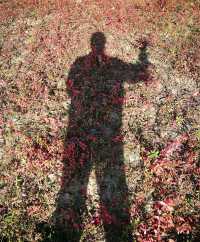Went in February, Punakaiki, about 50km north of Greymouth, to today's first major attraction, Pancake Rock (Pancake Rocks). In many pancake rock travel notes and guides mentioned, if tourists are lucky to catch the rising tide, the seawater through a large number of vertical water spray holes, will occasionally appear fountain-like rumbling water column, showing a spectacular scenery. Many tourists did not catch up with the rising tide when they came here, so they brought some regrets. But obviously we had a bad weather a few days ago, the RP now began to erupt, when it came just in time for the water level to rise, the sea through the rock under the hole rumbling eruption, the waves caused by more than ten meters, almost from the water level hit the tourist high observation deck! New Zealand's attractions, parks and other natural landscapes are free, including pancake rock here. Although free, New Zealanders love to set up various billboards in the scenic area, explaining why you see the scenery like a fruit shell (such as why the blue lake seen in Mount Cook is green), and help you see the scenery from a more interesting angle (For example, in the Pancake Rock scenic spot below), these many billboards are designed to give tourists a better experience. In fact, there are more other signs in various natural landscapes, some showing how spectacular scenery was decades ago, and how much has disappeared after human destruction or climate change. Some billboards show rare creatures that are only there, and even due to environmental changes around the world, New Zealand has become the last place for some creatures to live, calling on everyone to protect the ecology. Can't help but lament that New Zealanders really love nature of the nation, but whenever you see these signs, the mood is very heavy, ecological protection we are really a long way to go, not only New Zealanders, but also the mission of all our people who love nature. I don't know if you have seen the "Tomb Robbery Notes", the sand in the Nuhai diving sand mentioned a creature growing in the water. When we first saw the so-called sea grass (Giant Mermaid''s Hair), we couldn't help but cry, isn't this "Forbidden"? It is too in line with our imagination, the author's uncle has definitely seen this product! After watching Pancake Rocks, how can I eat a Pancake? Very user-friendly, when you visit the pancake rock, you will immediately see a Pancake Cafe, catch up with noon, taste the most popular banana bacon pancake, real material, two people can't finish...
;
Punakaiki Review
4.6 /544 Reviews
Popular Destinations
Desah Travel | Subic Bay Travel | Jeddah Travel | Nanchang Travel | Surigao Travel | Kunshan Travel | Sapporo Travel | Phu Quoc Island Travel | Tashkent Travel | Hanoi Travel | Suzu Travel | Ningbo Travel | Sri Lanka Travel | Ulaanbaatar Travel | Kiambogo Area Travel | Magelang Travel | Bourdeaux Travel | Port Dickson Travel | Tures Travel | Davao de Oro Travel | Purni Travel | Agharous Travel | Corrego Novo Travel | La Polka Travel | Baddi Travel | Mangwadgaon Travel | Amble Travel | Talagskiy Gorodok Travel | Dalton Township Travel | Sinio Travel
Recommended Attractions at Popular Destinations
Bangkok attraction near me | Tokyo attraction near me | Manila attraction near me | Hong Kong attraction near me | Taipei attraction near me | Seoul attraction near me | Los Angeles attraction near me | New York attraction near me | Shanghai attraction near me | Kuala Lumpur attraction near me | Shenzhen attraction near me | Osaka attraction near me | Singapore attraction near me | London attraction near me | Guangzhou attraction near me | San Francisco attraction near me | Beijing attraction near me | Macau attraction near me | Bali attraction near me | Paris attraction near me | Ho Chi Minh City attraction near me | Orlando attraction near me | Jakarta attraction near me | Phuket attraction near me | Chicago attraction near me | Toronto attraction near me | Istanbul attraction near me | Dallas attraction near me | Cebu attraction near me | Seattle attraction near me
Popular Attractions
Colosseum | Splendid China Folk Village | Window of the World | Ghibli Museum | Lingyin Temple | Huangpu River Tour(16 Pu Pier) | Humble Administrator's Garden | King Power Mahanakhon Sky Walk | Disneyland Park | Shamian Island | SEA LIFE Bangkok Ocean World | Chao Phraya River | The West Lake | Jing'an Sculpture Park | Muangboran the Ancient City (Samut Prakan) | Wings of Time | Museo de Motos Juan Antonio Garcia | Church of San Benito Abad | Go Ebike Bali | Iglesia romanica de Sant Vicenc d'Obiols | Winkleigh Cider Company | The Crazy Golf | Columbia Golf Club | Flight School Austriafly | Museu Felicia Leirner | Kronprinzenbruecke | Beijing Wildlife Park | Hong Kong Disneyland | Paris Ferris Wheel | Chimelong Water Park
Popular Travelogues
Payment Methods
Our Partners
Copyright © 2024 Trip.com Travel Singapore Pte. Ltd. All rights reserved
Site Operator: Trip.com Travel Singapore Pte. Ltd.
Site Operator: Trip.com Travel Singapore Pte. Ltd.




























